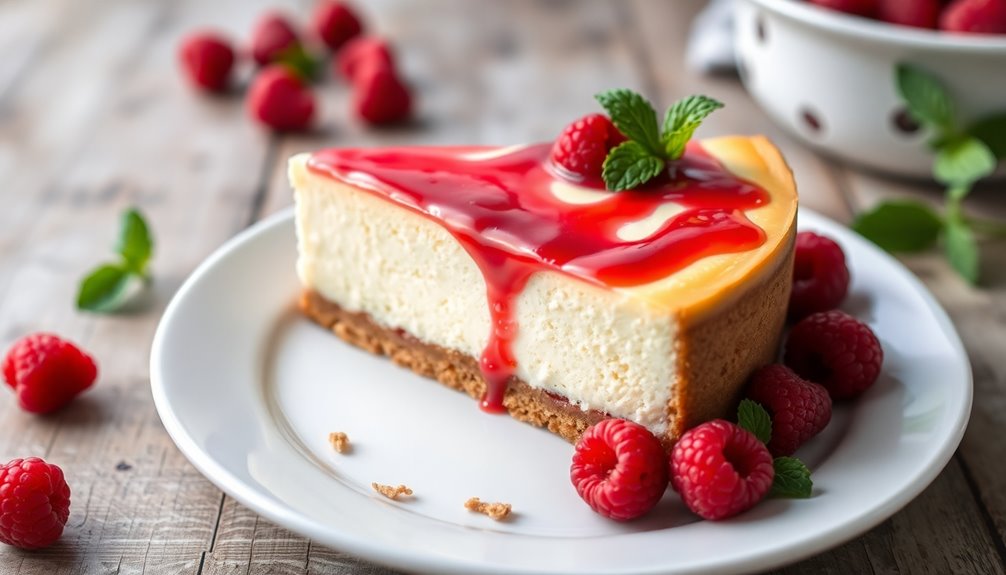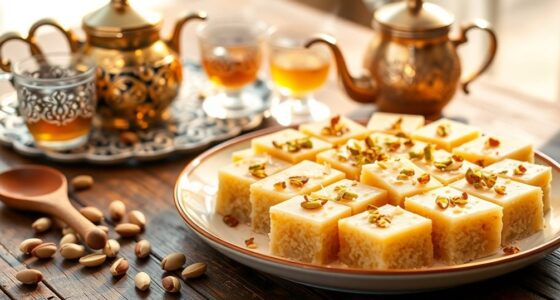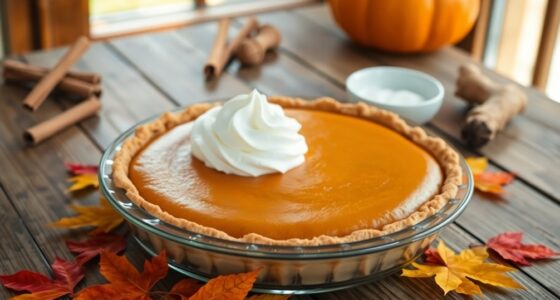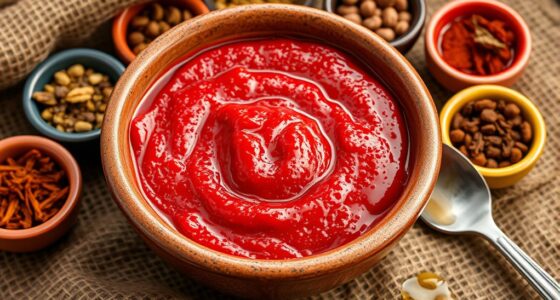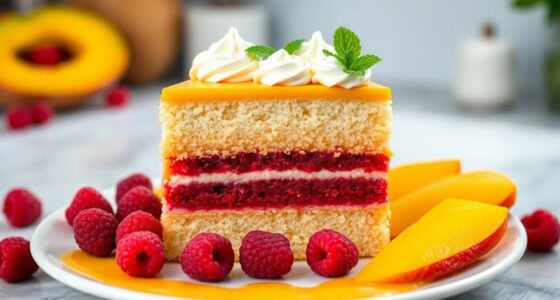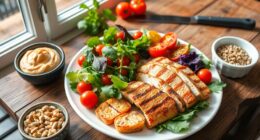Using flour in cheesecakes adds richness and stability, giving you a creamy texture that's hard to resist. It helps prevent cracks and enhances the overall presentation. A typical recipe includes 1 to 2 tablespoons of flour for every 16 ounces of cream cheese. Baking at 325°F allows the cheesecake to set perfectly. Plus, you can experiment with gluten-free options like almond flour. Stick around to discover more about perfecting your cheesecake creations!
History

When you delve into the history of cheesecakes, you'll find that the use of flour has deep roots, dating back to ancient Greece. Early cheesecakes combined simple ingredients like cheese, flour, and honey, fueling athletes during the Olympic Games.
As time progressed, traditional European recipes added flour to provide structure and stability to the filling. The 19th century introduced cream cheese and sugar in American cheesecakes, creating denser variations that sometimes included flour for a cake-like texture.
In modern cheesecake recipes, particularly New York style, flour enhances richness and stability, blending historical techniques with contemporary flavors. This evolution showcases how flour transformed cheesecake into a celebrated dessert with both creamy and structured qualities.
Recipe

In this recipe, we'll combine cream cheese, sugar, eggs, and a touch of all-purpose flour to create a deliciously rich cheesecake. The baking process will ensure that the cheesecake sets perfectly while maintaining a smooth and creamy filling. Follow the steps below for a delightful dessert that's sure to impress.
Ingredients:
- 16 ounces cream cheese, softened
- 1 cup granulated sugar
- 1 teaspoon vanilla extract
- 3 large eggs
- 2 tablespoons all-purpose flour
- 1 cup graham cracker crumbs (for crust)
- 1/4 cup unsalted butter, melted (for crust)
- 2 tablespoons sugar (for crust)
- Pinch of salt (for crust)
Instructions:
Preheat your oven to 325°F (163°C). In a large mixing bowl, beat the softened cream cheese until smooth. Gradually add the sugar and vanilla extract, mixing until fully incorporated.
Add the eggs one at a time, mixing gently after each addition. Finally, sift in the flour and mix until just combined.
In a separate bowl, combine the graham cracker crumbs, melted butter, sugar, and a pinch of salt, then press this mixture into the bottom of a 9-inch springform pan to form the crust.
Pour the cheesecake filling over the crust and smooth the top with a spatula. Bake for 50 to 60 minutes, or until the edges are set and the center is slightly jiggly.
Turn off the oven and leave the cheesecake inside for an additional hour to cool gradually.
Extra Tips:
To achieve the best results, make sure that all ingredients are at room temperature before mixing, as this will help create a smooth filling.
Avoid overmixing the batter to prevent incorporating too much air, which can lead to cracks in the surface.
Once the cheesecake is baked, allow it to cool completely at room temperature before refrigerating for at least four hours or overnight. This resting time is crucial for the cheesecake to firm up and develop its flavors fully.
For added flavor, consider topping with fresh fruit or a fruit coulis before serving.
Cooking Steps

To start your cheesecake, preheat your oven to 325°F for optimal baking.
Next, mix the cream cheese and sugar until smooth, ensuring a rich base for your batter.
After that, you can add the eggs one at a time, blending each in before moving on to the sour cream.
Step 1. Preheat Oven to 325°F
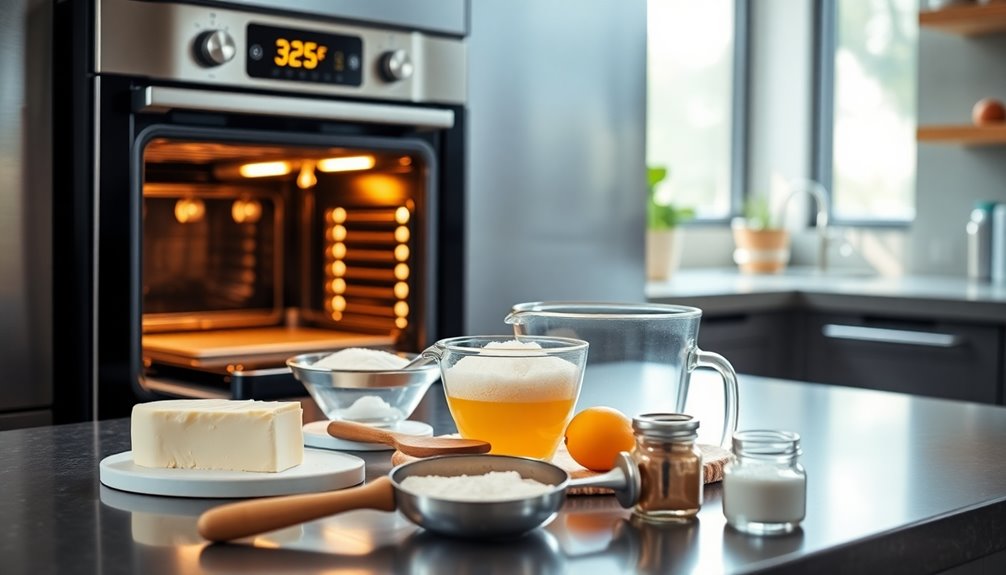
Preheating your oven to 325°F is essential for baking cheesecakes with flour, as this temperature promotes even cooking and minimizes the risk of cracks.
To achieve the best results, preheat the oven before mixing your cheesecake batter. Using a water bath during baking helps maintain moisture, which is crucial for a smooth texture.
At this oven temperature, your cheesecake will typically require about 50-70 minutes to bake, depending on your recipe. Keep an eye on the internal temperature to ensure it's just right.
Once baked, allow the cheesecake to cool gradually in the oven by turning off the heat and leaving the door slightly ajar, preventing sudden temperature changes that could cause cracks.
Step 2. Mix Cream Cheese and Sugar
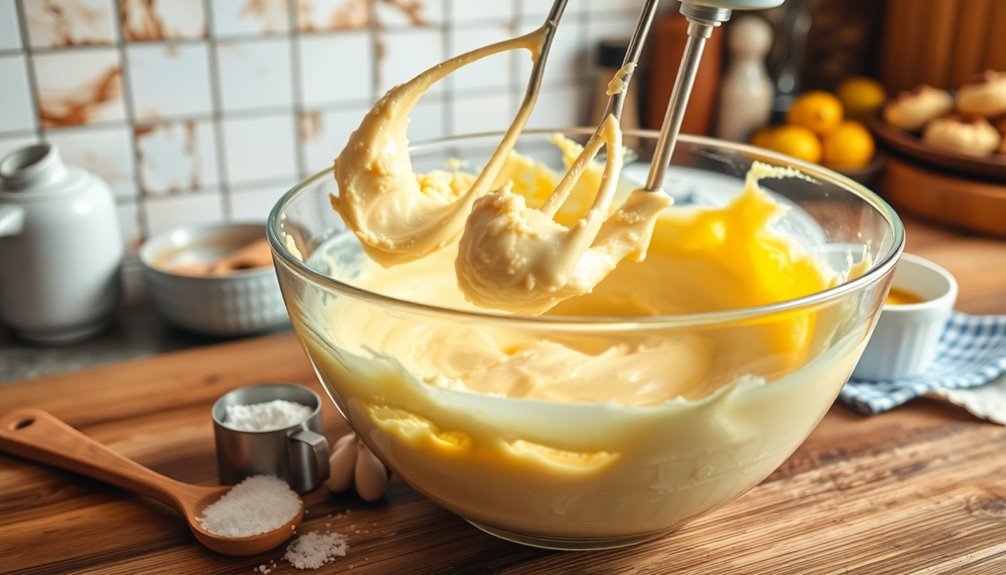
Start by bringing your cream cheese to room temperature; this step ensures a smooth blend with the sugar and eliminates any lumps.
Using an electric mixer on medium speed, blend the cream cheese and sugar together. Gradually add the sugar to the cream cheese, mixing continuously to allow for even distribution. This process helps dissolve the sugar effectively, creating a smooth mixture.
Scrape down the sides of the mixing bowl with a spatula periodically to ensure everything's well incorporated. Continue mixing for about 2-3 minutes until the batter is creamy and free of clumps.
Once your cream cheese and sugar mixture is perfectly smooth, it's ready for the next ingredients, like flour and eggs, to be incorporated into the batter.
Step 3. Add Eggs One at a Time

With the cream cheese and sugar mixture now smooth and creamy, it's time to add the eggs.
Start by adding eggs one at a time to your cheesecake batter. This method ensures a smooth and uniform mixture, preventing overmixing that can lead to a dense texture.
Beat the cream cheese and sugar thoroughly before adding the first egg; this helps create a creamy consistency. After adding the first egg, mix just until combined, then introduce the next.
This careful incorporation contributes to a lighter cheesecake texture, as each egg provides essential structure and stability during baking. Following this technique reduces the risk of curdling or over-aerating, resulting in a delightful cheesecake you'll love.
Step 4. Blend in Sour Cream

Once your cream cheese and sugar mixture is perfectly smooth, it's time to blend in the sour cream.
Make sure your sour cream is at room temperature to achieve that smooth, creamy consistency without any lumps. For every 8 ounces of cream cheese, use about 2 tablespoons of sour cream.
This addition not only enhances the richness and creaminess of your cheesecake batter but also brings a delightful tangy flavor that balances the sweetness.
Blend the sour cream with the cream cheese and sugar until the mixture is smooth. It's crucial to do this before adding the eggs, as overmixing can lead to cracks.
Incorporating sour cream also improves the overall texture, making your cheesecake less dense and creamier.
Step 5. Pour Into Prepared Pan

Carefully pour the creamy cheesecake filling into your prepared crust, ensuring you leave a little space at the top for the batter to rise while baking.
If you're using a cheesecake pan, gently tap it on the counter to release any air bubbles.
If you're opting for a water bath, wrap the outer pan in heavy-duty foil to prevent water from seeping into your cheesecake during baking.
Then, place the cheesecake pan inside the outer pan and fill it with hot water before putting it in the oven.
Bake at the specified temperature, usually around 325°F, until the edges are set and the center remains slightly wobbly.
This indicates your cheesecake is perfectly done!
Final Thoughts

While you may think of cheesecakes as purely creamy indulgences, incorporating flour can significantly enhance their texture and stability. When you use flour in your cheesecake recipe, it adds structure that helps prevent cracking, resulting in a smoother presentation.
Typically, you'll want to include 1 to 2 tablespoons of flour per 16 ounces of cream cheese. If you're aiming for a gluten-free option, consider substituting almond flour or cornstarch.
Just remember, using flour may require slight adjustments to baking time or temperature to ensure your cake cooks perfectly without becoming dry.
Frequently Asked Questions
What Does Adding Flour to Cheesecake Do?
Adding flour to cheesecake transforms it into a slice of perfection, balancing creaminess with structure!
It stabilizes the batter, making your cheesecake firmer and easier to slice. Flour absorbs excess moisture, preventing that dreaded sogginess, especially when you're using wet ingredients.
Just remember, you'll want to mix carefully to avoid a tough texture. With just a tablespoon or two, you can achieve that ideal cake-like consistency some bakers crave.
Does Baked Cheesecake Contain Flour?
Yes, baked cheesecake can contain flour.
It's often added to provide structure and stability, helping the filling set properly during baking. If you're aiming for a creamier texture, you might use 1 to 3 tablespoons of flour, depending on your desired consistency.
However, some recipes skip the flour altogether, relying on eggs and cream cheese for a lighter, smoother result.
What Makes New York Cheesecake Different Than Regular Cheesecake?
Imagine you're at a bakery, eyeing a New York cheesecake. What sets it apart from regular cheesecake is its dense, creamy texture, thanks to a higher cream cheese ratio.
You'll notice it's firmer, often baked at a lower temperature to prevent cracks.
While other cheesecakes might flaunt various flavors or toppings, New York cheesecake typically shines with a simple graham cracker crust and minimal embellishments, allowing that rich cream cheese flavor to take center stage.
What Is the Secret to the Best Cheesecake?
The secret to the best cheesecake lies in a few key techniques.
Start with room temperature cream cheese to ensure a smooth batter, and don't skip the pinch of salt for balanced flavor.
Bake it in a water bath to avoid cracks and promote even cooking.
After baking, let it cool gradually in the oven, then refrigerate for at least eight hours.
These steps combined will give you a rich, creamy cheesecake that everyone will love.
